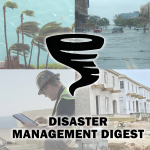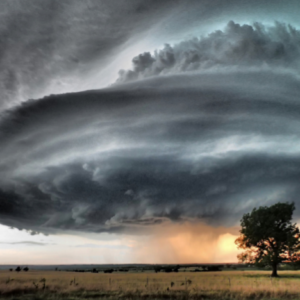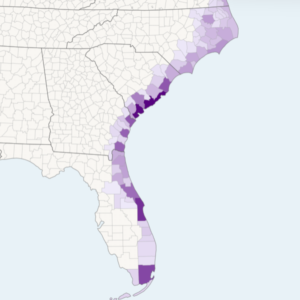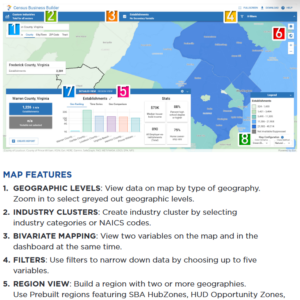AccuWeather’s hurricane prediction
 AccuWeather predicts a “Supercharged September” as we enter the peak of hurricane season, data shows huge increases in extreme hurricane rainfall that could cost hundreds of billions of dollars, the U.S. Census is out with a new tool to identify communities and business sectors that need the most post-disaster help, plus FEMA is out with new National Resilience Guidance. It’s all in this week’s Disaster Management Digest.
AccuWeather predicts a “Supercharged September” as we enter the peak of hurricane season, data shows huge increases in extreme hurricane rainfall that could cost hundreds of billions of dollars, the U.S. Census is out with a new tool to identify communities and business sectors that need the most post-disaster help, plus FEMA is out with new National Resilience Guidance. It’s all in this week’s Disaster Management Digest.
 “Supercharged September”: While the 2024 hurricane season has been predicted to be well-above normal, so far only two named storms – Debby and Ernesto – have made landfall this August thanks to dry, dusty air circulating about the Atlantic. But this respite may soon come to an end according to updated predictions from AccuWeather meteorologists, who warn of a September surge in hurricane activity with a shift of weather patterns. Between six and 10 tropical storms are forecasted in the month of September, with possibilities of multiple storms in the Atlantic at the same time, potentially rivaling the record-breaking September 2020 season. With record-breaking sea surface water temperatures, we should be on high alert for the peak of hurricane season on September 10 and the “parade of storms” that may come along with it. AccuWeather warns that October and well into November may still stir up storms of varying intensity, forecasting a total of 20-25 named storms by year’s end, well above the average of 14. So far, we’ve had five named storms.
“Supercharged September”: While the 2024 hurricane season has been predicted to be well-above normal, so far only two named storms – Debby and Ernesto – have made landfall this August thanks to dry, dusty air circulating about the Atlantic. But this respite may soon come to an end according to updated predictions from AccuWeather meteorologists, who warn of a September surge in hurricane activity with a shift of weather patterns. Between six and 10 tropical storms are forecasted in the month of September, with possibilities of multiple storms in the Atlantic at the same time, potentially rivaling the record-breaking September 2020 season. With record-breaking sea surface water temperatures, we should be on high alert for the peak of hurricane season on September 10 and the “parade of storms” that may come along with it. AccuWeather warns that October and well into November may still stir up storms of varying intensity, forecasting a total of 20-25 named storms by year’s end, well above the average of 14. So far, we’ve had five named storms.

Storm Flooding Risk from Deep Sky Research
When it Rains it Pours: Deep Sky Research, a carbon removal project developer, has analyzed 40 years of climate data to bring us the startling discovery that the frequency of extreme hurricane rainfall has surged more than 300% over the last four decades – and its severity has grown by 33% according to Deep Sky’s proprietary machine learning. More specifically, this means that severe hurricane rainfall, once seen every 100 years, is now rearing its ugly head every 25 years. It is projected to cause over $450 billion in hurricane damage over the next five years, including widespread flooding and power outages that can exacerbate secondary effects like heat exposure. Today’s worst case scenario hurricane is far more dangerous and costly than in years past and the effects are compounding, with Florida and Texas expected to bear much of the losses. You can read the full report here.
 New Tool to ID Vulnerable Communities: The US Census Bureau’s Census Business Builder (CBB) is a new tool built to help identify vulnerable areas to better allocate emergency funding after a disaster and update relevant information in real time. Economic and demographic information from impacted areas can streamline the disaster recovery process – generating color-coded maps and charts with breakdowns for the most affected sectors and residents. Such presentations of data are far more digestible, and help us understand the widespread effects of storm systems. One example is the major system that hit Rhode Island in January of this year that has been broken down piece by piece using the CBB, here.
New Tool to ID Vulnerable Communities: The US Census Bureau’s Census Business Builder (CBB) is a new tool built to help identify vulnerable areas to better allocate emergency funding after a disaster and update relevant information in real time. Economic and demographic information from impacted areas can streamline the disaster recovery process – generating color-coded maps and charts with breakdowns for the most affected sectors and residents. Such presentations of data are far more digestible, and help us understand the widespread effects of storm systems. One example is the major system that hit Rhode Island in January of this year that has been broken down piece by piece using the CBB, here.
 FEMA’s New National Resilience Guideline: FEMA has recently announced the release of its new National Resilience Guidance. The guidance offers a unifying vision of resilience and the principles and steps all communities and organizations can take to increase their resilience in every sector and discipline. FEMA will host a series of 60-minute webinar sessions in September and October to discuss the National Resilience Guidance and additional resources available to help new and experienced resilience practitioners improve their communities’ resilience. To view the document and learn more about the webinar sessions, you can visit the FEMA website at National Resilience Guidance | FEMA.gov.
FEMA’s New National Resilience Guideline: FEMA has recently announced the release of its new National Resilience Guidance. The guidance offers a unifying vision of resilience and the principles and steps all communities and organizations can take to increase their resilience in every sector and discipline. FEMA will host a series of 60-minute webinar sessions in September and October to discuss the National Resilience Guidance and additional resources available to help new and experienced resilience practitioners improve their communities’ resilience. To view the document and learn more about the webinar sessions, you can visit the FEMA website at National Resilience Guidance | FEMA.gov.
LMA Newsletter of 9-3-24

